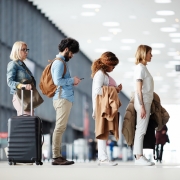USING OMNICHANNEL CUSTOMER SERVICE IN HOSPITALITY
The hospitality industry focuses heavily on face-to-face communication. However, the digital revolution has now forever changed almost every aspect of our world — perhaps none more so than customer service.
The way that hospitality companies handle customer service has changed dramatically in recent years. More than a decade ago, there were only three ways to contact a company – by phone, fax or going into a physical block-and-mortar location.
Today, you can take your pick; phone, email, live chat, SMS and social media. The list appears endless. The challenge for many companies is not only to be accessible in these channels, which is important, but for those channels to deliver consistent and an integrated service quality.
DIGITAL VS THE HUMAN TOUCH
Omnichannel does not simply focuses on digitalization.
While more and more hospitality-based businesses are turning to technology to stay ahead of the competition (think smart TVs, self-service check-in kiosks, in-room lighting apps), a sizeable percentage of consumers still seek immediate contact with front-line staff – even if they prefer to use self-service or digital options first – making face-to-face interactions a more traditional, yet equally important part of the customer experience strategy.
According to Digital Commerce 360 businesses with a solid omnichannel policy retain 89% of their customers, while companies that don’t have a similar policy retain only 33% of their customers. Additionally, Forbes Magazine reported that more than half of consumers have switched brands due to a poor customer service experience. This is why it’s so important for brands to have a powerful customer experience that is consistent across every channel.
For example, while customers may research a vacation online, look for recommendations on social media sites then make a purchase via their mobile, they may still call your contact center and, when they do, it’ll likely be important. Getting through to a knowledgeable staff member can be the make or break in the final purchasing decision, therefore highlighting the need for unity across digital and human support platforms.
CUSTOMER JOURNEY CONSISTENCY
It’s clear that self-service kiosks and other digital channels must work together with face-to-face interaction to create a holistic experience for guests. Each guest will want something different from the customer experience. It’s up to the individual business to give them what they want.
Creating consistency on every channel improves the customer experience as well as the brand image. The benefits of consistency in the omnichannel user experience include:
- Familiarity and Brand Confidence: A consistent experience sets expectations for future interactions with your organization and builds user confidence.
- Learnability: Consistent guest experiences are more learnable for users who have interacted with your solutions on various other channels.
- Efficiency: When designs and features are consistent, customers can complete tasks faster and more efficiently on the channel of their choice in the context of their everyday lives.
- Trust: Users crave consistency and companies that can provide consistent experiences across channels will quickly earn users’ trust and build credibility.
In addition to being consistent, cross-channel experiences must be monitored and analyzed to ensure a seamless customer experience is truly being delivered.
MEASURING YOUR OMNICHANNEL SUPPORT STRATEGY
An incredible number of hospitality-based businesses that spend time and money building omnichannel service fail to perform the last step – researching the results. How do you really know the investments you have made are working, both for your customers and your bottom line? This is where Omnichannel Research Solutions can provide valuable insights into how your investments are performing.
While your company probably has a website, Facebook, Twitter, maybe even an app, your teams also have training opportunities invested to ‘match’ the messaging your platforms are marketing. With the right customer research solutions, all of these tools, from your online branding to your employee’s training, can be used to engage and connect with your customers in hopes to provide a seamless customer experience. For example Omnichannel Research Solutions from BARE International are aggregated into one platform, giving you insights on how your platforms – from your brick and mortar locations to your Yelp page and more – are working together to create a seamless customer experience.
No matter which channels you choose to use in customer service, the priority is, and always will be, to provide a helpful and honest experience that will continue to grow your relationship with your customers. Arming yourself with immediate feedback from customer research allows you to take action and deliver a positive image of your brand allowing you to provide top-notch customer support.
CONCLUSION
The modern hospitality industry is posed with the challenge of effectively communicating with a younger, digital-savvy customer base while still providing the service and traditional models that guests expect and demand, like human interaction.
By understanding the unique needs of guests through customer experience research, a solid omnichannel strategy will allow establishments to effectively communicate, engage, and convert guests of different ages, affinities, and expectations.










